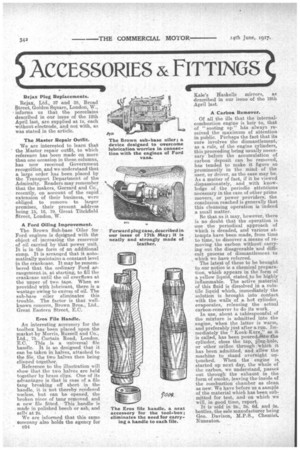ACCESSORIES &FITTINGS
Page 18

If you've noticed an error in this article please click here to report it so we can fix it.
Rejax Plug Replacements.
Rejax, Ltd., 37 and 38, Broad Street, Golden Square, London, W., informs us that the porcelains described in our issue of the 12th April last, are supplied at is. each without ,electrode, and not with, as was stated in the article.
The Master Repair Outfit.
We are interested to learn that the Master repair outfit, to which reference has been made on more than one occasion in these columns, has now received Government recognition, and we understand that a large order has been placed by the Transport Department of the Admiralty. Readers may remember that the makers, Gerrard and Co:, recently, on account of the rapid extension of their business, were obliged to remove to larger premises, their present address being 15, 16, 19, Great Titchfield Street, London, W.
A Ford Oiling Improvement.
The Brown Sub-base Oiler for Ford engines is designed with the object of increasing the reservoir of oil carried by that power unit. It is in the form of an additional sump. -It is arranged that it automatically maintains a constant level in the crankcase. It may be remembered that the ordinary Ford arrangement is, at starting, to fill the crankcase until the oil overflows at the upper of two taps. When so provided with lubricant, there is a wastage owing to excess of oil. The sub-base oiler eliminates this trouble. The factor is that wellknown concern, Brown Bros., Ltd.. Great Eastern Street, RC.
Eros Pile Handle.
An interesting accessory for the toolbox has been placed upon the market by Morris, Russell and Co., Ltd.,_ 75. Curtain Road, London, RC. This is a universal file handle. It is so designed that it can he taken in halves, attached to the file, the two halves then being dinned together.
Reference to the illustration will show that the two halves are held together by brass clips. One of its savantag&s is that in case of a file tang breaking off short in the handle, it is not thereby rendered useless, but can be opened, the broken piece of tang removed, and a new file fitted. This handle is made in polished beech or ash, and sells at.
We are informed that this same company also holds the agency for C54 Kale's Haskells mirrors, as described in our issue of the 19th April last.
A Carbon Remover.
Of all the ills that the internalcombustion engine is heir to, that of "sooting up " has always received the maximum of attention in public. Perhaps the fact that its cure involves the dismantlement, as a rule, of the engine cylinders, this proceeding being usually necessary before the accumulation of carbon deposit can be removed, has tended to make it figure so prominently in the mind of the user, or driver, as the case may be. As a matter of fact, if it be viewed dispassionately, and with knowledge of the periodic attetitions necessary in the case of other prime movers, or power providers, the conclusion reached is generally that this cleansing operation is indeed a small matter.
Be that as it may, however, there is no doubt that the operation is one the periodical approach of which is dreaded, and various attempts have been made, from time to time, to discover a means of removing the carbon without carrying out the disagreeable and difficult process of dismantlement to which we have referred.
The latest of these to be brought to our notice is a chemical preparation, which appears in the 'form of a yellow liquid, stated to be highly inflammable. The active material of this fluid is dissolved in a volatile liquid which, immediately the solution is brought into contact with the walls of a hot cylinder, evaporates, releasing the actual carbon-remever to do its work.
In use, about a tablespoonful of the mixture is admitted into the engine, when the latter is warm, and preferably just after a run. Immediately the Kook-Kure," as it is called, has been poured,rtsto The cylinder, close the tap, plug-hole, or other orifice through which it has been admitted, and allow the machine to stand overnight untouched. When the engine in started up next day, the whole of' the carbon, we understand, passes out, through the exhaust in the form of smoke, leaving the inside of the combustion chamber as clean as new. We have before us a sample of the material which has been submitted for test, and on which we will, in good time, report. It is sold in 2s., 3s. 6d. and 5s. bottles, the sole manufacturer being Geo. Davison, M.P.S., Chensiist, Nuneaton.




















